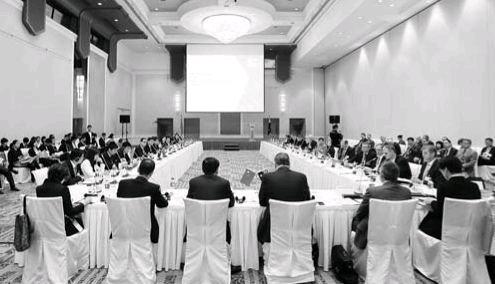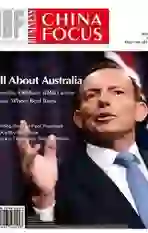Australia: Offshore RMB Center
2014-09-22
The journey of Mr. Tony Abbott to China included two important goals: making the Chinese market more open to Australians and having more Chinese invest in Australia. The two-way relation is the key to improve the cooperation between China and Australia.
The cooperation could be everywhere and finance is definitely one of the most important sector given Chinas growing importance attached to the financial service and the great advantages Australia has in it.
On April 11, Joe Hockey, Australian Minister for Finance, said that Australia was actively promoting the interna- tionalization of RMB. Now, the central banks of China and Australia are studying into the potential of Sydney as the RMB trade and settlement center.
“This is good news for enterprises from both countries,” said Zhou Xin, the partner of banking sector at King & Wood. “From the current situation, the good news for Chinese enterprises is all for the fund settlement.”
Zheng Yang, director of Shanghai Municipal Office of Financial Affairs said that RMB is more than simple settlement currency, it could be the investment currency as well.
“Our destination point is to establish Sydney as a financial service trading center. We are still on the journey. When Xi Jinping went to Europe last month(March), Frankfurt in Germany was going to be established as an offshore trading center. We are not hitting that position, but that is definitely where we are inspired to be and we understand both governments are working together towards that sort of objective,” Michael Clifton, Deputy Consul-General (Commercial) of Australia in China, said to CBF.
Lower Exchange Cost and Risk
When Julia Eileen Gillard, former Prime Minister of Australia, visited China last year, the two countries reached an agreement on the direct trading between Chinas RMB and Australian dollar, marking the start of Sydneys journey to be an offshore RMB center. The Australian dollar thus became the third currency that can be directly traded with RMB after the US dollar and Japanese yen.
This February, Bank of China and Australian Stock Exchange (ASX) signed on the RMB clearing agreement, turning the Chinese bank into the only clearing bank in the RMB clearing system in Australia.
“Sydneys plan to become an offshore RMB center can be a driving force for the China-Australia trade in the short term. Enterprises, no matter they are in China or Australia, can settle the trade with the RMB, which could reduce the exchange cost and the exchange rate risk,” said Zhou Xin. The development of Sydney as an offshore RMB center, can not only promote the RMB to be used as a settlement currency in Australia, but also help to elevate it to be the currency for trade financing and investment.
“So far as I know, many Australian enterprises, especially the mining enterprises, are more willing to directly hold and use RMB to reduce the time and cost spent on exchange as much as possible,” said Elmer Funke Kupper, CEO and Managing Director of ASX. These enterprises do not consider RMB as the currency for trading and investment rather than the one for speculation. Their RMB capital is directly deposited in their banking accounts. The statistical data shows that the volume of direct trading between Australian dollar and RMB increased dramatically in the past one year from US$324 million before the agreement to the present US$2.4 billion.
ASX plans to launch the RMB payment platform this July, Kupper said that the preparation went well as many banks were ready to accept it. “This is not a trading project, but a payment platform that could connect all banks together. RMB is one of the most important trading currencies and the size of the platform is going to grow bigger and bigger as the times goes by.”
Reduce Financing Cost
“Due to the appreciation of RMB and other factors, the holders of RMB are not definitely going to exchange the RMB into US dollar or Australian dollar. At this time, some investment channels are used to maintain and increase the value of the RMB,” said Zhou Xin. As the RMB is playing an increasingly important role in the trade settlement and clearing in Australia and the Australian banks are providing more RMB deposits and loans, the corresponding trend is going to be passed to the capital market.“In the future, there are more and more RMB investment tools, such as the dim sum bonds.”
On April 9, the branch of Bank of China in Sydney successfully issued the 2-year Oceania Bonds valuing 2 billion yuan with the fixed interest rate of 3.25%, making it become the first RMB bonds in Australia. As the front-running RMB bond in Australia, the Oceania Bonds were give active response by local investors. The subscription value was higher than 4.9 billion yuan, 1.45 times as high as the planned value.
Zhou Xin said: “In the future, Chinese enterprises can go public in Australia with RMB and issue more shares. Presently, the exchange rate cost of overseas RMB is at least 3-4 percent lower than in China. For Chinese enterprises, the RMBs increasing presence in Australia is good for them to reduce the financing cost. The enterprises are able to use the RMB from successful fundraising flexibly in either foreign trade and moving it into China.”
“The increasing presence of RMB in Australia is an important reason for us to go public in Australia,” said Dong Chen, board secretary of Zhonghuanyun Industrial Development Co, Ltd. The company went public in AsiaPacific Stock Exchange this March. “We knew that the RMB was going to be a major offshore trading currency in Australia. This is what attracts us.”
According to Zhou Xin, when the RMB trade and investment environment gradually got matured, Australia is going to become an offshore RMB derivative market with an increasing size, allowing investors to seek profits inside it.
Enjoy the Tax and Favorable Tariff
Kupper said frankly that Sydney would have a great space for improvement even though it could never reach the size of London as the biggest foreign exchange trading center in the world.
“As an offshore center, the biggest advantage of Australia is that it has a great deal volume with China.” In 2013, the total trading volume between China and Australia was close AU$150 billion, accounting for one quarter of the total foreign trade of Australia. Zhou Xin stressed that the trading relation was very interesting as most of it concentrated on Chinas importation of minerals and other materials from Australia. Due to trade surplus Australia has against China, Australia is able to build a RMB capital pool. “Compared with London, the accumulation of RMB might be different and the difference could also be found in RMB holders and utilities.”
It is worthwhile to mention that the banks from Australia and China had begun to set up branches in each othersland, which further promoted the internationalization of RMB. Last year, five Chinese banks started their business in Sydney and had fast development.
On April 10, ANZ Bank opened a branch in the Shanghai Free Trade Zone. Michael Smith, president of ANZ Bank, said that this deal would help clients enjoy the favorable conditions in tax and tariff in international trade and financing.
